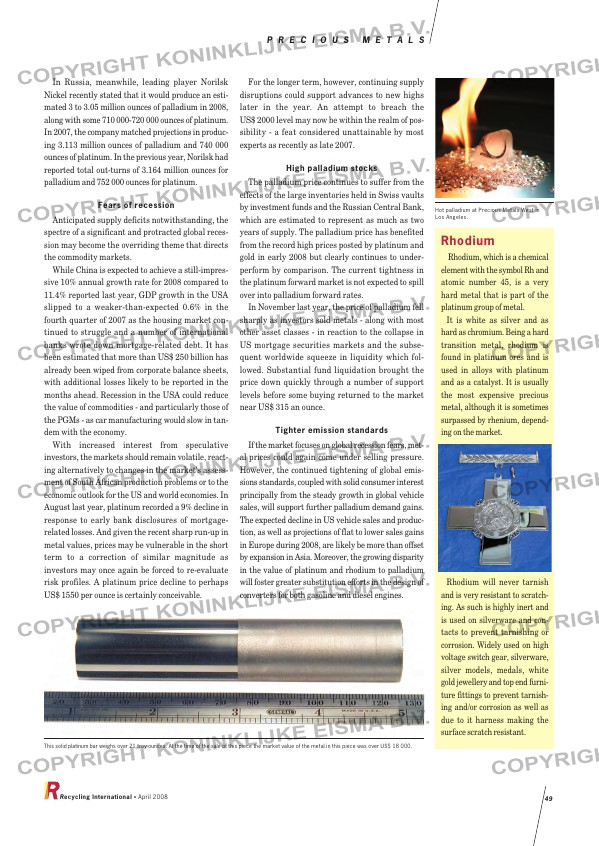Page 49 from: April 2008

In Russia, meanwhile, leading player Norilsk
Nickel recently stated that it would produce an esti-
mated 3 to 3.05 million ounces of palladium in 2008,
along with some 710 000-720 000 ounces of platinum.
In 2007, the company matched projections in produc-
ing 3.113 million ounces of palladium and 740 000
ounces of platinum. In the previous year, Norilsk had
reported total out-turns of 3.164 million ounces for
palladium and 752 000 ounces for platinum.
Fears of recession
Anticipated supply deficits notwithstanding, the
spectre of a significant and protracted global reces-
sion may become the overriding theme that directs
the commodity markets.
While China is expected to achieve a still-impres-
sive 10% annual growth rate for 2008 compared to
11.4% reported last year, GDP growth in the USA
slipped to a weaker-than-expected 0.6% in the
fourth quarter of 2007 as the housing market con-
tinued to struggle and a number of international
banks wrote down mortgage-related debt. It has
been estimated that more than US$ 250 billion has
already been wiped from corporate balance sheets,
with additional losses likely to be reported in the
months ahead. Recession in the USA could reduce
the value of commodities – and particularly those of
the PGMs – as car manufacturing would slow in tan-
dem with the economy.
With increased interest from speculative
investors, the markets should remain volatile, react-
ing alternatively to changes in the market’s assess-
ment of South African production problems or to the
economic outlook for the US and world economies. In
August last year, platinum recorded a 9% decline in
response to early bank disclosures of mortgage-
related losses. And given the recent sharp run-up in
metal values, prices may be vulnerable in the short
term to a correction of similar magnitude as
investors may once again be forced to re-evaluate
risk profiles. A platinum price decline to perhaps
US$ 1550 per ounce is certainly conceivable.
For the longer term, however, continuing supply
disruptions could support advances to new highs
later in the year. An attempt to breach the
US$ 2000 level may now be within the realm of pos-
sibility – a feat considered unattainable by most
experts as recently as late 2007.
High palladium stocks
The palladium price continues to suffer from the
effects of the large inventories held in Swiss vaults
by investment funds and the Russian Central Bank,
which are estimated to represent as much as two
years of supply. The palladium price has benefited
from the record high prices posted by platinum and
gold in early 2008 but clearly continues to under-
perform by comparison. The current tightness in
the platinum forward market is not expected to spill
over into palladium forward rates.
In November last year, the price of palladium fell
sharply as investors sold metals – along with most
other asset classes – in reaction to the collapse in
US mortgage securities markets and the subse-
quent worldwide squeeze in liquidity which fol-
lowed. Substantial fund liquidation brought the
price down quickly through a number of support
levels before some buying returned to the market
near US$ 315 an ounce.
Tighter emission standards
If the market focuses on global recession fears, met-
al prices could again come under selling pressure.
However, the continued tightening of global emis-
sions standards, coupled with solid consumer interest
principally from the steady growth in global vehicle
sales, will support further palladium demand gains.
The expected decline in US vehicle sales and produc-
tion, as well as projections of flat to lower sales gains
in Europe during 2008, are likely be more than offset
by expansion in Asia. Moreover, the growing disparity
in the value of platinum and rhodium to palladium
will foster greater substitution efforts in the design of
converters for both gasoline and diesel engines.
Rhodium
Rhodium, which is a chemical
element with the symbol Rh and
atomic number 45, is a very
hard metal that is part of the
platinum group of metal.
It is white as silver and as
hard as chromium. Being a hard
transition metal, rhodium is
found in platinum ores and is
used in alloys with platinum
and as a catalyst. It is usually
the most expensive precious
metal, although it is sometimes
surpassed by rhenium, depend-
ing on the market.
Rhodium will never tarnish
and is very resistant to scratch-
ing. As such is highly inert and
is used on silverware and con-
tacts to prevent tarnishing or
corrosion. Widely used on high
voltage switch gear, silverware,
silver models, medals, white
gold jewellery and top end furni-
ture fittings to prevent tarnish-
ing and/or corrosion as well as
due to it harness making the
surface scratch resistant.
Hot palladium at Precious Metals West in
Los Angeles.
This solid platinum bar weighs over 21 troy ounces. At the time of the sale of this piece the market value of the metal in this piece was over US$ 18 000.
P R E C I O U S M E T A L S
Recycling International • April 2008 49
RI_013_Precious Metals:Opmaak 1 03-04-2008 15:49 Pagina 49



